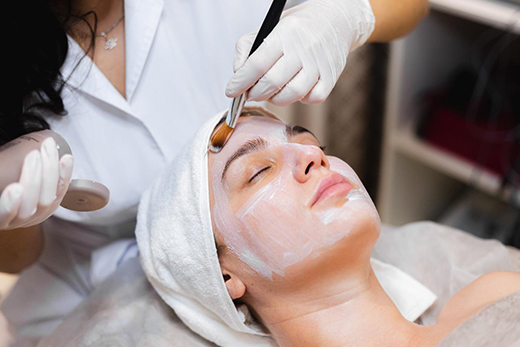Pranjal Shah
07-Oct-2025
Once limited to surface fixes like peels and fillers, skincare now taps into neuroscience.
Skin, being an organ like any other, is constantly interacting with the brain. The brain, accordingly, responds to signals and stress cues from the skin and in turn influences how the skin ages, heals, and reacts. This two-way dialogue, known as the skin–brain axis, is precisely what neurocosmetics seek to harness. At the heart of this new field are the ‘big three’ therapies: microbiome, exosome and polynucleotide. Supported by data-driven diagnostics, these advances go beyond surface-level fixes to restore balance at both the cellular and neurological levels. In doing so, neurocosmetics reframe skincare not just as an aesthetic transposition but as organ-to-organ care, where visible beauty and psychological well-being are treated integrally.
What are neurocosmetics?
Once upon a time, skincare was simply about smoothing wrinkles or fading blemishes. Accordingly, the phrase 'cosmetic treatment' only alludes to treatments such as dermaplaning, laser resurfacing, skin tightening and dermal fillers. Neuro-cosmetics on the other hand, are no longer about superficial restructuring; they merge biology, psychology, and technology into a single, evidence-backed ecosystem of care. These tackle visible signs of ageing and stress while also calming the nervous system, reducing stress-driven inflammation, and even uplifting mood. Add to this the precision of data-driven diagnostics, and skincare evolves from a one-size-fits-all ritual into a personalised strategy that speaks to both the skin and the brain. The result is not just healthier, firmer, more resilient skin, but also a subtle psychological ease that comes with harmonised functioning of the body.
What are the treatments under Neurocosmetics?
Microbiome Treatment
The human skin has an ecosystem of its own called a microbiome. These countless microbes actively interact with the skin and the nervous system and help maintain the skin barrier, enhance hydration, support wound healing and reduce disease-related flares such as acne or atopic reactions. Modern neurocosmetics leverage this potential using three strategies: prebiotics, for selectively feeding beneficial microbes; probiotics, which introduce live strains to temporarily colonise the skin; and postbiotics, to deliver bacterial metabolites that directly modulate immune and nerve activity. Together, these approaches calm redness and irritation, strengthen the skin’s natural defences, and promote overall skin health. Microbiome therapies also help lower stress signals sent to the brain, helping us feel calmer, emotionally balanced and at ease.

(Picture Credits: Freepik)
Exosome Treatment
Exosomes are nanosized extracellular vesicles acting as the skin’s courier system. They carry proteins, lipids, and microRNAs between cells, prompting fibroblast activity, collagen synthesis, tissue repair, inflammation control, and even nerve excitability. Since exosome treatments signal repair and healing at the cellular level and downregulate inflammatory pathways, the brain perceives greater comfort, and therefore, the psychological consequence is reduced stress, better emotional stability and sensory relief. Thus, exosome treatment not only supports firmer, smoother, and healthier skin but also improves the overall psychological experience of skin care, helping users feel more relaxed, confident, and mentally at ease.
Polynucleotide Treatment
Polynucleotides are fragments of DNA which serve a dual function as building blocks and biological signals. These are essentially tasked with triggering tissue renewal by stimulating fibroblasts to produce collagen and elastin, enhancing cellular metabolism, reducing oxidative stress, and checking inflammatory gene expression. The ensuing outcome goes beyond improving skin texture and elasticity to calm stress-driven skin reactivity. When redness, flare-ups, or sensitivity are reduced, the nerve signals relayed to the brain also shift. The subconscious stress carried by our brain notes a decline, which promotes a general sense of emotional comfort. Ultimately, polynucleotides facilitate long-term skin regeneration by rebuilding dermal architecture, enhancing resilience, and calming stress pathways. In simple terms, polynucleotide treatments quieten distressing signals from our skin on top of rejuvenating it.

Picture Credits: Freepik
Data-Driven Diagnostics
Not precisely a treatment per se, and more of a supplement thereof, it involves using multispectral imaging to detect subtle changes in the skin’s barrier function, pigmentation, and stress-related inflammation while also integrating genomic and epigenetic data. It begins with a multimodal baseline scan, often including visual imaging, skin conductance, and salivary cortisol. You can also include data from wellness apps and gadgets, such as circadian rhythm, mood, and skin changes over time, to support the data. Treatment plans are then adjusted in accordance with the data so collected. For instance, probiotic serums may be recommended for barrier imbalance, exosome injections for collagen loss, or polynucleotide treatment for inflammatory reactivity. Thus, it allows for personalisation of the treatment based on the condition of the skin backed by systematic evidence. In short, your face becomes less of a canvas for guesswork and more of a dashboard, where skincare runs on data instead of trial and error.
Cover Credits: Freepik